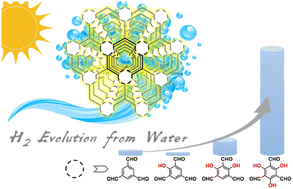Bandgap engineering of covalent organic frameworks for boosting photocatalytic hydrogen evolution from water†
Abstract
Solar light-promoted hydrogen production from water using covalent organic frameworks (COFs) as a photocatalyst is an attractive technique for clean energy sources. To boost the photocatalytic performance of COFs, it is necessary to narrow their bandgap. However, the bandgap engineering of COFs at the molecular level is less explored. Here, we synthesized four COFs using 2,4,6-tris(4-aminophenyl)-1,3,5-triazine with 1,3,5-triformylbenzene, 2,4,6-triformylphloroglucinol, 2,4,6-triformylphenol, and 2,4,6-triformylresorcinol, respectively, denoted as COF-OH-n (n = 0–3, representing the number of –OH groups). The different degrees of proton tautomerism in COF-OH-n arise from the different numbers of β-ketoenamine linkages in their skeletons, leading to the regulation of the visible light absorbing ability, bandgap, and band edge positions of COF-OH-n. Due to irreversible proton tautomerism in COF-OH-3, it exhibited the most suitable band structures with a bandgap of 2.28 eV and a flat band of −0.62 eV among COF-OH-n, resulting in the highest photocatalytic hydrogen production rate from water (i.e., 9.89 mmol g−1 h−1), while the other COFs delivered significantly low photocatalytic performances (e.g., ∼0, 0.11, and 2.91 mmol g−1 h−1 for COF-OH-1, COF-OH-0 and COF-OH-2, respectively).

- This article is part of the themed collection: 2023 Journal of Materials Chemistry A Lunar New Year collection


 Please wait while we load your content...
Please wait while we load your content...